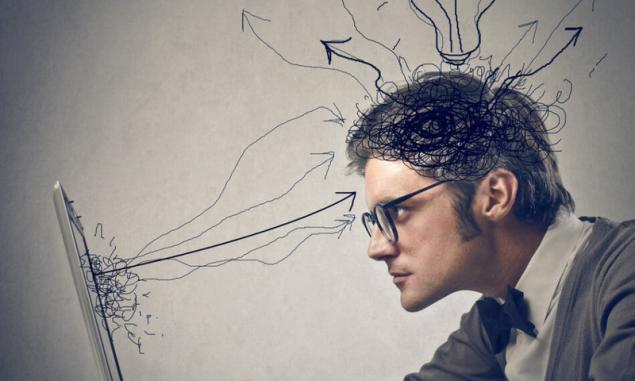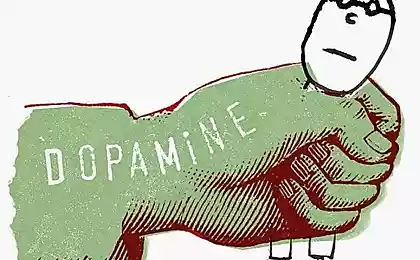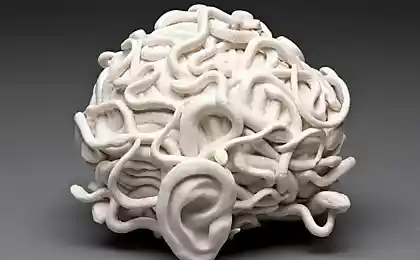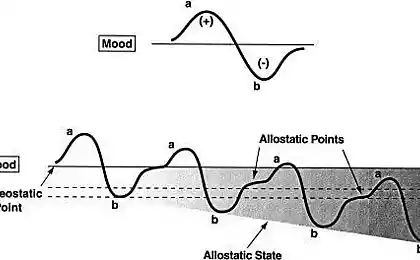631
As dopamine helps to think
Dopamine activates the neural system that supports working memory, and suppresses the other work that distracts us from what needs to be done.
Neurons transmit signals to each other via neurotransmitters, and while neurotransmitters are used in different neural networks, it often turns out that a particular molecule is a neurotransmitter associated with us with any one function. Thus, for example, about dopamine often heard in connection with the reinforcement system (or reward system) and a sense of pleasure. Weight of various dependencies or addictions, just hiding in the nerve centers of the reinforcement system, so that when we talk about the bad habits of craving to overeat, a drug, it will inevitably go down and dopamine.

But, in addition, dopamine is needed more and neural pathways responsible for motor activity - typical lethargy and the inability to control their movement, resulting in the syndrome of Parkinson's develop just because of the death of dopaminergic neurons (ie, those that produce dopamine) <. br>
Finally, it is necessary for a number of higher cognitive functions -. Especially for working memory
The working memory brain stores something with which he is working here right now: a poem that you need to talk in class, name of the person you need to call back about the order, abstracts, you need to send a letter, etc .;. in a sense, it can be compared with the cache of the computer processor. We know that when we are engaged in some particular case, in the brain is activated by a special fronto-parietal neural network (FPCN - frontoparietal control network) and at the same time decreases the activity of the so-called defoltnoy network (DN - default network), which works when the brain is not nothing busy when our thoughts wander somewhere in uncertainty. And it is believed that just helps to activate the dopamine neuronal system that supports working memory and disable the other, which distracts us from what needs to be done.
More details to present the work of dopamine after failed experiments employees General clinical hospital of Massachusetts. Joshua Roffman (Joshua Roffman) and his colleagues were able to combine the two techniques - functional magnetic resonance imaging (fMRI) and positron emission tomography (PET)
. fMRI allows you to determine the activity of certain areas of the brain: if the person in the MRI scanner, set any task, we will see what neural networks are busy its decision, and which, on the contrary, rest
. MRI images of the human brain.
As for the pet, then it can help to assess the distribution of some of the molecules, or cells on which they sit - it requires a radioactive drug that, once in the body, it will contact with the molecule, we need
.
The distribution of the neurotransmitter gamma-aminobutyric acid in the limbic system of the brain, photographed using a positron emission tomography.
In the course of the volunteers of the experiment were scanned by magnetic resonance scanner and then compared how the human brain at rest and during a test on the memory (the man had to remember certain sequence of letters, and then looking for the next emerging letters to determine whether they were in previous series or not). As expected, during mental exercises FPCN default 'network and the network parted with each other: the first activity increased, the second activity fell
. Then the experiment participants were given radioactively labeled agent that binds to dopamine receptors D1 (optional researchers made sure that the substance is more than anything else is not reacted) - now dopamine receptors could be seen using PET
. In an article in Science Advances states that the density directly corresponds to how dispersed both neural networks (ie how activated FPCN, responsible for working memory, and how much "fall asleep» DN). Moreover, in neurons of default network DN density of dopamine receptors was higher, that is, obviously, dopamine differently affect the performance of both networks.
Anyway, we get the following scheme: where we need to focus on solving some problems, the brain uses dopamine in order to separate the two neural networks to the one of them, which is responsible for working memory, could be involved in the full capacity
<. br> Here, however, it is necessary to clarify two things:
First, the authors of assessed only the density of receptors for dopamine, and dynamics of neurotransmitter they are not tracked;
secondly, all volunteers equally well coped with the test, so there was no way to know how to match variations in the activity of neural networks (and still the same receptor density) level of the memory itself.
Other researchers involved in this subject, note that similar tests on the memory man performs better than the stronger linked above network - which is somewhat contrary to the new data. At the same time, experiments on primates have shown that the relationship between the number of dopamine receptors and working memory is, but it is not easy: the memory works well only when some optimum receptors, if too much or too little, then begin cognitive problems In general, though, we now better understand how dopamine - or rather, its receptor - involved in thought processes, for neurobiologists here still have a lot of work. But in the future, maybe we can get rid of neuropsychiatric disorders associated with the inability to concentrate, and improve mental, and not only mental, labor - if we learn to properly act on the dopamine system of the brain.
Neurons transmit signals to each other via neurotransmitters, and while neurotransmitters are used in different neural networks, it often turns out that a particular molecule is a neurotransmitter associated with us with any one function. Thus, for example, about dopamine often heard in connection with the reinforcement system (or reward system) and a sense of pleasure. Weight of various dependencies or addictions, just hiding in the nerve centers of the reinforcement system, so that when we talk about the bad habits of craving to overeat, a drug, it will inevitably go down and dopamine.

But, in addition, dopamine is needed more and neural pathways responsible for motor activity - typical lethargy and the inability to control their movement, resulting in the syndrome of Parkinson's develop just because of the death of dopaminergic neurons (ie, those that produce dopamine) <. br>
Finally, it is necessary for a number of higher cognitive functions -. Especially for working memory
The working memory brain stores something with which he is working here right now: a poem that you need to talk in class, name of the person you need to call back about the order, abstracts, you need to send a letter, etc .;. in a sense, it can be compared with the cache of the computer processor. We know that when we are engaged in some particular case, in the brain is activated by a special fronto-parietal neural network (FPCN - frontoparietal control network) and at the same time decreases the activity of the so-called defoltnoy network (DN - default network), which works when the brain is not nothing busy when our thoughts wander somewhere in uncertainty. And it is believed that just helps to activate the dopamine neuronal system that supports working memory and disable the other, which distracts us from what needs to be done.
More details to present the work of dopamine after failed experiments employees General clinical hospital of Massachusetts. Joshua Roffman (Joshua Roffman) and his colleagues were able to combine the two techniques - functional magnetic resonance imaging (fMRI) and positron emission tomography (PET)
. fMRI allows you to determine the activity of certain areas of the brain: if the person in the MRI scanner, set any task, we will see what neural networks are busy its decision, and which, on the contrary, rest
. MRI images of the human brain.
As for the pet, then it can help to assess the distribution of some of the molecules, or cells on which they sit - it requires a radioactive drug that, once in the body, it will contact with the molecule, we need
.
The distribution of the neurotransmitter gamma-aminobutyric acid in the limbic system of the brain, photographed using a positron emission tomography.
In the course of the volunteers of the experiment were scanned by magnetic resonance scanner and then compared how the human brain at rest and during a test on the memory (the man had to remember certain sequence of letters, and then looking for the next emerging letters to determine whether they were in previous series or not). As expected, during mental exercises FPCN default 'network and the network parted with each other: the first activity increased, the second activity fell
. Then the experiment participants were given radioactively labeled agent that binds to dopamine receptors D1 (optional researchers made sure that the substance is more than anything else is not reacted) - now dopamine receptors could be seen using PET
. In an article in Science Advances states that the density directly corresponds to how dispersed both neural networks (ie how activated FPCN, responsible for working memory, and how much "fall asleep» DN). Moreover, in neurons of default network DN density of dopamine receptors was higher, that is, obviously, dopamine differently affect the performance of both networks.
Anyway, we get the following scheme: where we need to focus on solving some problems, the brain uses dopamine in order to separate the two neural networks to the one of them, which is responsible for working memory, could be involved in the full capacity
<. br> Here, however, it is necessary to clarify two things:
First, the authors of assessed only the density of receptors for dopamine, and dynamics of neurotransmitter they are not tracked;
secondly, all volunteers equally well coped with the test, so there was no way to know how to match variations in the activity of neural networks (and still the same receptor density) level of the memory itself.
Other researchers involved in this subject, note that similar tests on the memory man performs better than the stronger linked above network - which is somewhat contrary to the new data. At the same time, experiments on primates have shown that the relationship between the number of dopamine receptors and working memory is, but it is not easy: the memory works well only when some optimum receptors, if too much or too little, then begin cognitive problems In general, though, we now better understand how dopamine - or rather, its receptor - involved in thought processes, for neurobiologists here still have a lot of work. But in the future, maybe we can get rid of neuropsychiatric disorders associated with the inability to concentrate, and improve mental, and not only mental, labor - if we learn to properly act on the dopamine system of the brain.
Three death: At what age a man's life hangs in the balance?
Gypsy recipe: Gorgeous hair you are guaranteed!























